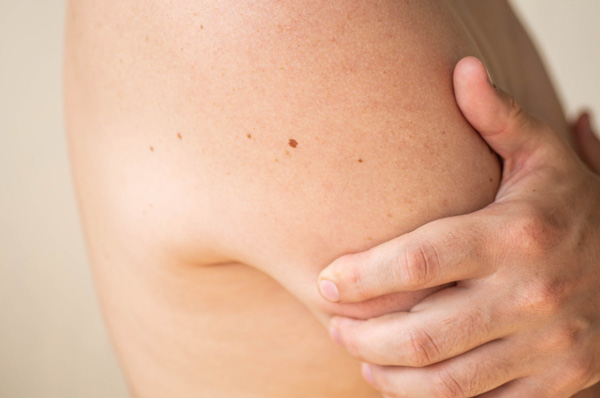Exploring the Skin Biopsy Process: What To Expect

Skin biopsies are common procedures that medical professionals use to diagnose various skin conditions, such as a rash, infections, inflammatory conditions, and skin cancer. While this procedure can make first-time patients a little nervous, it is a straightforward diagnostic process that can help providers rule out serious health conditions. Knowing what to expect can help alleviate any anxiety you may be feeling before your appointment.
What happens during a skin biopsy?
If a medical provider discovers an atypical skin lesion or mole, they may recommend a same-day biopsy or a biopsy at a later date. Skin biopsies are a quick in-office procedure. The provider will administer a local anesthetic to numb the treatment area, ensuring the patient will not feel any pain or discomfort during the process.
There are a few different types of skin biopsies, including:
- Shave biopsy. During this biopsy, the provider uses a tool (similar to a razor) to scrap the surface of the patient's skin. The provider gathers a cell sample from the top layers of the skin, known as the epidermis and dermis. Stitches are not typically necessary after this type of biopsy.
- Punch biopsy. During this biopsy, the provider uses a round-tipped cutting tool to remove a small core of skin. The sample may include deeper layers of skin and the top layer of fat under the skin. The patient may need stitches after a punch biopsy.
- Excisional biopsy. During this biopsy, the provider uses a scalpel to remove an entire lump or area of atypical skin, possibly including a border of healthy skin and the skin's deeper layers. Like a punch biopsy, the patient may need stitches.
The type of skin biopsy will depend on the patient's symptoms and how much of their skin is affected. A skin biopsy typically takes about fifteen minutes to complete.
After the skin the skin biopsy
The healthcare provider may instruct the patient to keep a bandage over the biopsy site until the following day. The biopsy site may bleed after the patient leaves the medical office, but this is more likely if the patient is taking blood-thinning medicine. If prolonged bleeding occurs, apply direct pressure to the wound for 20 minutes. If it is still bleeding, do another compression session. The patient should contact their healthcare provider if the second 20 minutes of compression does not stop the bleeding.
The provider will instruct the patient on properly caring for the biopsy site as it heals. They should avoid bumping the area or doing activities that stretch the site. Additionally, bathing, swimming, or going in a bathtub can irritate the biopsy site. Wait until cleared by one's provider—this is typically about a week after the procedure.
Cleaning and aftercare
Healing can take several weeks, with biopsy sites on the legs and feet taking the longest. It is important to be patient during this time. Clear the biopsy site two times a day unless it is on the scalp since patients should only clean scalp wounds once daily. Follow the following steps to reduce complications during the healing process:
- Wash hands with soap and water before touching the affected area.
- Wash the biopsy site with soap and water; if on the scalp, use shampoo.
- Rinse the area well and pat dry with a clean towel.
- Apply a thin layer of petroleum jelly with a new cotton swab.
- Cover the site with a bandage for two to three days after the procedure.
Patients with stitches should continue wound care until the healthcare removes them.
Scarring
The biopsy site will likely leave a scar but gradually fade over time; the permanent color will set a year or so after the biopsy. Depending on the patient's skin color, they may develop a keloid scar, which is thick and raised from the rest of the skin. This type of scar is common in people with brown or Black skin and for those who have a biopsy taken from their neck, back, or chest.
Results
The tissue sample collected during the biopsy will be sent to a laboratory for analysis by a pathologist. Depending on the complexity of the analysis, it may take several days to receive the results. Once the results are available, the healthcare provider will discuss them with the patient and recommend appropriate treatment options based on the diagnosis.
Call our office if you have further questions
While a skin biopsy may seem intimidating, this routine procedure is essential for diagnosing and treating various skin and other health conditions. If you have any questions or concerns about the biopsy process, do not hesitate to call our office. Your health and well-being are our first priority, and we are here to support you every step of the way.
Request an appointment here: https://www.janeylhammonsnpc.com or call Janey L Hammons NP-C at (580) 922-4406 for an appointment in our Seiling office.
Check out what others are saying about our services on Yelp: Skin Biopsy in Seiling, OK.
Recent Posts
Birth control contains hormones that can serve as contraception, acne treatment, or help manage conditions like endometriosis and PCOS. No matter the reason you are searching for “birth control near me,” you likely have several options to sift through. Knowing the basics of each option and its efficacy can help you narrow down the search…
General lab work can help keep track of your overall health and diagnose medical issues in their early stages. Many people wonder how often they should have lab tests to maintain their health. Knowing the testing recommendations can help you make better choices about preventive care.General lab work includes common tests. These tests include: Complete…
Adult sick visits are important for maintaining your general health. Daily activities may change due to some irregular symptoms. Studies reveal that even the mildest symptoms can become overwhelming enough to disrupt a person’s quality of life. If what you are feeling does not need urgent care, you can see your primary provider. Here are…
Aging skin is a part of life. Its natural ability to stay hydrated and smooth decreases as people age, leading to fine lines and wrinkles. Fortunately, proactive anti-aging treatments can strengthen the skin's defenses and stimulate the body's ability to produce collagen. However, the skincare market is oversaturated with numerous products and procedures, so it…


